Nothing seems to be scarier than seeing something that you thought is a baby roach crawling on your kitchen floor. But then, you suddenly realize that it was not really a roach but rather a bug.
So what kind of bug is it? Is it also bad and dangerous to have one in my house? How can I tell if it is a cockroach or not?
What bug looks like a baby cockroach? Bugs that looks like a baby cockroach includes bed bugs, giant water bugs, wood-boring beetles, Palo Verde beetles, ground beetles, June bugs, and red flour beetles. All of them have different characteristics, but they have a very strong resemblance to cockroaches.
Cockroaches are very creepy and disgusting insects, so no wonder most of us scream when we see lots of them.
But then, some bugs can also be present in our house and can be mistaken for cockroaches. In this guide, you will know some of the common ones, and their similarities and differences with roaches.
What are the Most Common Cockroaches?
There are about 69 cockroach species across North America, but only five of them are considered notorious pests.
Outdoors, the most common ones are the oriental cockroach, wood cockroach, and American cockroach. Meanwhile, the most common roaches in houses are the German and brown-banded cockroaches.
Related: What Is a Cockroach? | Comprehensive Overview
What do Baby Roaches Look Like?
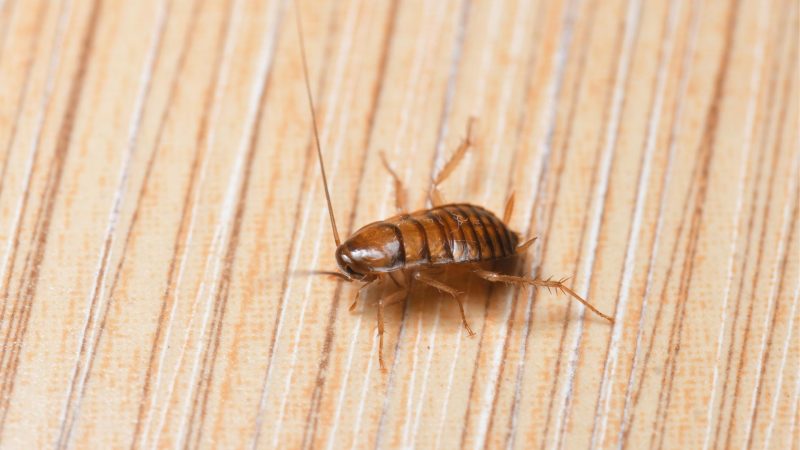
Baby roaches look like their adult version, except that they are smaller. Also, their wings are not yet fully developed, or they do not have wings at all.
But just like adults, cockroach nymphs have flattened oval bodies, slender antennae, and six legs. They also feed on the same food and live in the same places as adults.
Related: What Do Baby Cockroaches Look Like? | Pictures and Descriptions!
How Long Before Baby Roaches Become Adults?
Roaches undergo three life stages – egg, nymph, and adult. Depending on the species, baby roaches go through 2-18 nymphal stages before becoming adults.
It takes about 160 days before brown-banded cockroach nymphs become adults, while American cockroach nymphs will take 215-400 days to grow into adults.
Palmetto Bug vs. Cockroach
Technically speaking, palmetto bugs and cockroaches are the same. Palmetto bug is another term for roaches that are usually found in and around palmetto trees.
Among the roach species that are usually referred to as palmetto bugs are American cockroaches, Smokybrown cockroaches, and Florida woods cockroaches.
Related: How to Get Rid of Palmetto Bugs? | Effective Methods and Prevention Tips
Bugs That Look Like Baby Roaches
1. Bed Bug
Scientifically known as Cimex lectularius, the common bed bug is probably the bug that is the most look-alike of small roaches. This is because both of them have flat, oval bodies, six legs, and two antennae.
Bed bugs are also wingless, can be brown or red when full of blood, and are about 3/16-inch (9.5 mm.) long. They are usually yellow or translucent if not recently fed and may look invisible.
Bed bugs undergo incomplete metamorphosis, which means they only pass through 3 life stages – egg, nymph, and adult. Bed bug nymphs have five larval stages, and they have to molt and feed on blood before going to the next stage.
Related: What Are Bed Bugs? (Origins, History, Evolution & More)
Bed Bugs vs. Baby Roaches
Unlike the bed bug, the baby roach will not suck your blood but can contaminate your food. Bed bugs don’t drink water, and they don’t transmit diseases to humans.
However, bed bug bites can cause redness and swelling of the skin. A severe bed bug infestation can also lead to emotional distress and insomnia.
Related: Bed Bugs vs. Roaches | Similarities and Differences
How to Get Rid of Bed Bugs Instantly?
Bed bugs are quite difficult to eradicate since they are very tiny and good at hiding in small spaces.
Although insecticides may be necessary for dealing with serious infestations, there’s no guarantee that they will not come back. Meanwhile, below are some natural ways to get rid of bed bugs instantly:
- Vacuum all infested items thoroughly and repeatedly. Alternatively, wash them with water at 122°F (50°C) for at least 20 minutes.
- For small items, place them in the freezer at 0°F (-17.7°C) for 2-4 days.
- Put the double-sided tape around your bed and bed posts. You can also use chemical-free bed bug interceptors, such as Ecopest Bed Bug Interceptors .
- Apply DE (Diatomaceous earth) in hidden places where bed bugs may be hiding.
Products such as HARRIS Diatomaceous Earth Food Grade act not only as a physical barrier; they also kill bed bugs on contact.
Related: Home Remedies for Bed Bugs in Your House – Complete Guide
2. Giant Water Bug
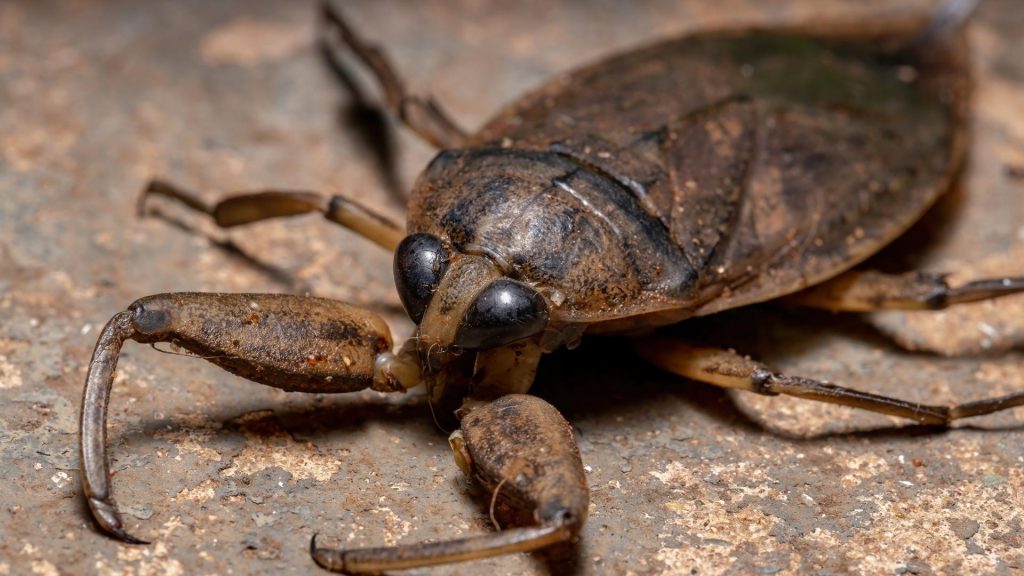
Scientifically known as Lethocerus americanus, giant water bugs are considered true bugs because they belong to the order Hemiptera.
These aquatic bugs are about 2-3 inches in length, but some species can grow 4 inches long. They are usually dark brown, with banded raptorial legs that allow them to catch things.
Adult giant water bugs and their nymphs feed on aquatic insects (larvae and adults), frogs, tadpoles, and small fishes.
These aquatic predators don’t have mouthparts or jaws. Instead, they have a needle-like rostrum to pierce their prey. Interestingly, a hungry giant water bug can eat prey 50 times its size.
Giant Water Bugs vs. Baby Roaches
Just like baby roaches, giant water bugs don’t have antennae and rarely bite humans but don’t carry diseases.
But unlike cockroaches, these insect predators lay eggs on water surfaces, and some male species carry the eggs until they hatch. They also breathe through snorkel-like breathing tubes at their hinds.
How to Get Rid of Giant Water Bugs Instantly?
Giant water bugs are sometimes considered beneficial bugs since they also feed on mosquito larvae.
But because they are attracted to lights, these insect predators may also enter your house and can be nuisance pests.
Fortunately, you don’t need pesticides to drive them away. To get rid of giant water bugs instantly, here are some simple things you can do:
- A study shows that giant water bugs are more attracted to incandescent light bulbs than to fluorescent light. As much as possible, replace your lights.
- Giant water bug bites can be painful but not medically dangerous. If there are only a few of them, wear safety gloves and put them out of your house.
- Don’t kill them. Instead, vacuum them carefully and set them free outside.
Related: Natural Ways To Get Rid of Waterbugs | Effective and Eco-Friendly Methods
3. Wood-boring Beetle
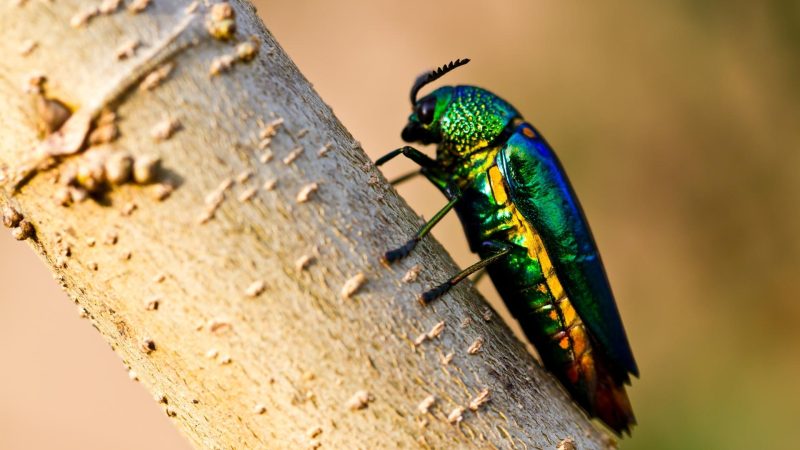
Wood-boring beetles are a family of beetles that damage and feed on wood and wooden products such as furniture and ladders.
They infest like termites, except that they are faster and create more damage, and their tunnels are not visible. Nonetheless, wood-boring beetles look more like baby roaches than termites.
Wood-boring beetles have three groups – deathwatch, powderpost, and false powderpost. Depending on the family, adult wood-boring beetles grow between 1/8-2 inches long.
Their color may vary from green, metallic blue, dark yellow, or red striped. Larvae have elongated, segmented cylindrical or flattened bodies.
Related: Powderpost Beetle | Identification, Habitat, and Behavior
Wood-boring Beetle vs. Baby Roaches
Unlike baby roaches, wood-boring beetle larvae usually remain inside the wood and make audible ticking sounds while chewing on it.
Once they become adults, these tiny beetles emerge through the round exit holes they chew. Also called woodworms, they are not harmful to humans, and they don’t carry diseases.
How to Get Rid of Wood-boring Beetle Instantly?
Finding wood-boring beetles can be challenging because all of their life stages are mostly in hidden wood junctions and beneath the wood surface.
A severe infestation is very hard to treat. So, if you see some adult wood-boring beetles emerging from the wood, here are some ways to get rid of them instantly:
- If possible, replace heavily-infested wood with a dry one.
- Paint the wood or apply varnish such as Epifanes Clear Varnish , especially on cracks and holes where wood-boring beetles could have laid eggs.
- Heat treatment of wood to 133°F (56.1°C) for 30 minutes can also kill wood-boring beetles.
- For small pieces of wood, place them in a deep freezer at 0°F (-17.7°C) for 72 hours. For wood thicker than 2 inches, treatment should be longer.
- Control moisture inside your home by installing, insulation, vapor barriers, and dehumidifiers such as Gocheer Upgraded Dehumidifier .
4. Palo Verde Beetle
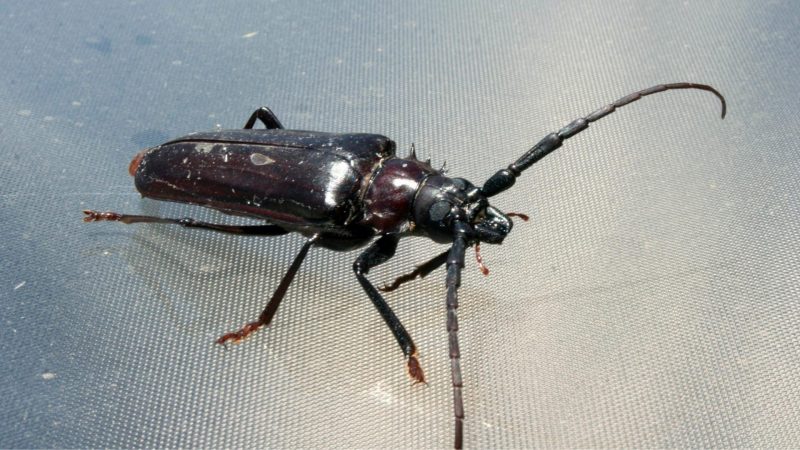
Scientifically known as Derobrachus geminatus, palo verde beetles are members of the family Cerambycidae. Adults are brown to black, about 3-3.5 inches long, with long antennae, and look like baby roaches.
On the other hand, larvae or grubs are creamy-white and can reach up to 5 inches in length.
Also called palo verde root borer, larvae of this cockroach look-alike beetle mostly feed on the woody tissue of tree roots, especially palo verde trees, hence the name.
Meanwhile, adults fly a lot and feed on fruits and nectar. However, they usually die about a month after mating but are still considered garden pests.
Palo Verde Beetles vs. Baby Roaches
Unlike small roaches, palo verde beetle larvae can live in tree roots for 3-4 years before they become adults. And although they are also attracted to light, these root-boring insects rarely enter homes.
Palo Verde beetles are not usually associated with human habitats and prefer living outdoors, especially in the wild.
How to Get Rid of Palo Verde Beetles Instantly?
Unfortunately, there is no proven method that can effectively control palo verde beetles.
As mentioned above, their larvae feed and live in the roots of plants, and insecticides will only be absorbed by the plant but will not kill these beetles. But since palo verde beetles are only seasonal pests, they will die naturally.
Palo verde beetles are usually more active between August and September. During these months, you may pick them up one by one to remove them. Just make sure you are wearing safety gloves.
They don’t bite, and they don’t carry diseases, but they will snip you a bit. If you have to kill them, simply step on them.
5. Ground Beetles
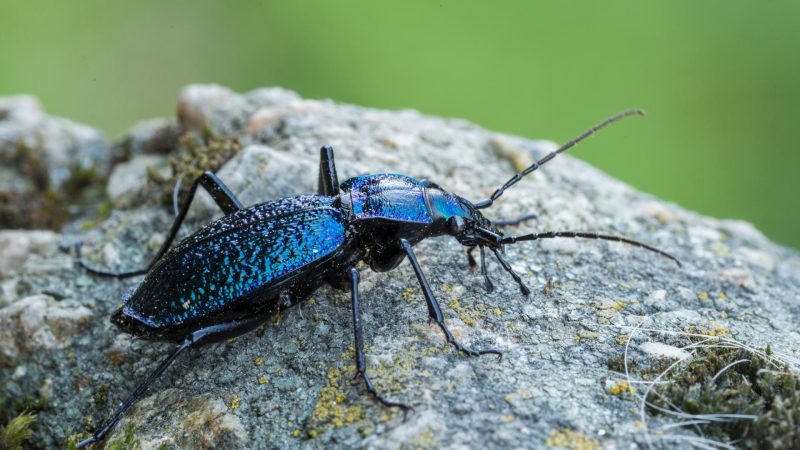
Scientifically known as Carabidae, ground beetles are about 1/8-1/2 inches long, but some species grow up to 1 inch in length. They have huge eyes, large jaws, thread-like antennae, and long, slender legs.
Most of them are black or brown. Just like baby oriental cockroaches, they have shiny, metallic, and flat bodies.
Ground beetles rarely fly, but they may accidentally enter homes and buildings, usually in mid and late summer. They are mostly found in hidden, damp areas, but they don’t reproduce indoors.
These nocturnal beetles feed on soft-bodied insects such as caterpillars, root maggots, slugs, snails, and wireworms.
Ground Beetles vs. Baby Roaches
Unlike baby roaches, ground beetles don’t damage properties and household structures. Also, their front wings are hardened, and their head is narrower than their neck.
They are also harmless to humans, and they don’t carry diseases. But despite being beneficial to plants, a huge population indoors can be annoying.
How to Get Rid of Ground Beetles Instantly?
Ground beetles are not dangerous to humans but rather beneficial. They only become nuisance pests once many of them enter your house.
Using pesticides is not a must unless the infestation is severe. But if you can detect them early, here are some sure ways to get rid of ground beetles instantly:
- Capture them in a container and get them free outside. or use a vacuum cleaner.
- You can also trap them with non-toxic sticky traps such as Faicuk 20-Pack Dual-Sided Yellow Sticky Traps .
- Ground beetles are attracted to bright lights, so you may reduce using lights or replace white bulbs with yellow ones.
- Place firewood away from your home and put inside only those that you can use for the day.
6. June Bug
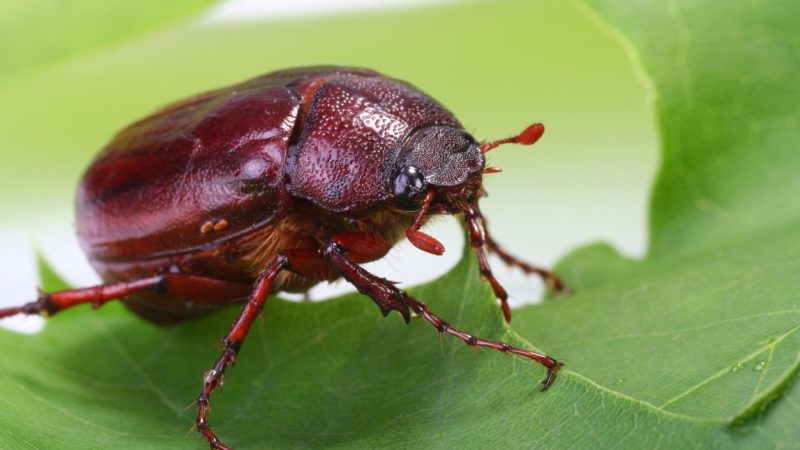
June bugs belong to the subfamily Melolonthinae and are most active from late spring to summer, hence the name.
They are also called May beetles, depending on where you live in North America. Adults are about 1/2-1 inch long, with 6 legs, and are mostly dark brown. Some of them are black, chestnut brown, or tan.
June bug larvae are cream in color, 1/8-1 inch long, with a C-shape body, yellow-brown head, and a grayish rear.
They feed on tree and shrub roots, grass, and broadleaf weed, causing the turf to turn brown and yellow. Meanwhile, June bug adults feed on the foliage of broadleaf plants and wheat and lay eggs in the turf.
June Bugs vs. Baby Roaches
Unlike baby roaches, May or June bugs are herbivorous beetles, which means they only eat plants. They also have rounded bodies rather than flat.
Also called grubs, their larvae spend 2 to 3 years in the soil before they become adults. Despite being destructive to plants, June bugs are not harmful to humans and pets.
How to Get Rid of June Bugs Instantly?
June bugs are mostly found in unhealthy lawns and very rare indoors. Adults are easier to find flying around, while their larvae usually live underground.
If your lawn has some holes and damaged grass stems, grubs are likely to be present. Here are some ways to get rid of June bugs before they can damage your lawn:
- For adult June bugs, you can trap them with equal parts of molasses (sweetener) and water placed in a tall bottle or jar.
- Alternatively, you can use a simple beetle trap, such as Spectracide Bag-A-Bug Japanese Beetle Trap .
- To get rid of the grubs, apply beneficial nematodes to your lawn from mid-summer to late summer. Products such as Bug Sales Beneficial Nematodes have Heterorhabditis bacteriophora, which are effective against June bugs.
- You may also apply milky spores, particularly in the fall when grubs are usually near the surface. Products such as St. Gabriel Organics Milky Spore Grub Control are mixed with water are ideal in a severe infestation.
- If an insecticide is necessary, use products that contain carbaryl, such as Gulfstream Sevin Ready to Use Bug Killer . For safety purposes, read the label carefully before using them.
7. Red Flour Beetle
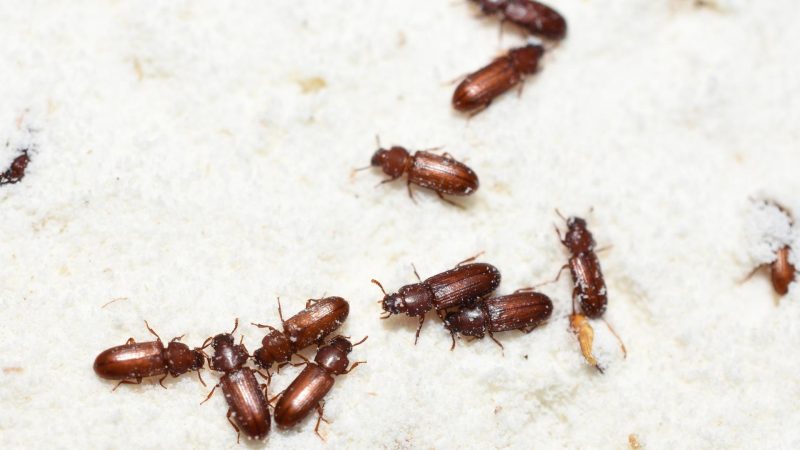
Scientifically known as Tribolium castaneum, red flour beetles are in the family Tenebrionidae, just like their closest relative, confused flour beetle (Tribolium confusum).
They are 1/8 to 3/16 inch long, dark cherry to dark brown, with a slightly curved thorax and antennae that end in a 3-segmented club.
Red flour beetles don’t feed on whole undamaged grain but rather on grains that have been damaged during storage or transportation or previously destroyed by other pests.
These notorious scavengers are commonly found in spice chocolate, museum specimens, and stored food products such as cereals.
Red Flour Beetles vs. Baby Roaches
A red flour beetle may be mistaken for a baby American cockroach. This is because they have the same dark color, and both of them can be seen adding contamination to damaged food.
However, these beetle species have elongated bodies instead of oval, and they don’t bite and transmit diseases to humans.
How to Get Rid of Red Flour Beetles Instantly?
Damaged grains with foul odor are usually due to the presence of red flour beetles and confused flour beetles. In most cases, you may also find dead bugs, cast skins, and fecal materials.
Sometimes, you may also live beetles in your grain bins. Here are some easy ways to get rid of red flour beetles instantly:
- Throw away heavily-infested grain and wash the bins thoroughly before replenishing supplies.
- Remove old grains from floors, corners, and walls of your storage area. If possible, vacuum the entire area.
- To kill flour beetles, place the infested food in a deep freezer at 0°F (-17.7°C) for at least 5 days.
- Heat treatment 125-140°F (51.6-60°C) for 30 to 45 minutes kills all life stages of these beetles.
Summary
Baby roaches pose the same health risks as adults. But still, you must know how to identify them correctly. This will reduce your worries and can also help you think of ways on how to deal with them. After all, most of the bugs mentioned above are not dangerous, and you can easily get rid of them.
List of Sources
Whitworth, R. J., Ahmad, A. (2007). Cockroaches. Kansas State University.
Potter, M. F. (2018). Cockroach Elimination in Homes and Apartments. University of Kentucky.
Sutherland, A. M., Choe, D. H., Lewis, V. R. (2013). Bed Bugs. University of California Agriculture & Natural Resources.
Mierow, T. Giant Water Bug. University of Minnesota.
Lewis, V. R., Seybold, S.J, (2010). Wood-Boring Beetles in Homes. University of California Agriculture & Natural Resources.
- How to Get Rid of Cockroaches? | Proven Strategies & Solutions! - June 24, 2023
- Powerful Homemade Wasp and Bee Sprays (with Recipes) - March 4, 2023
- Crazy Ants Invasion | Eradicate & Prevent Unwanted Guests - February 24, 2023
